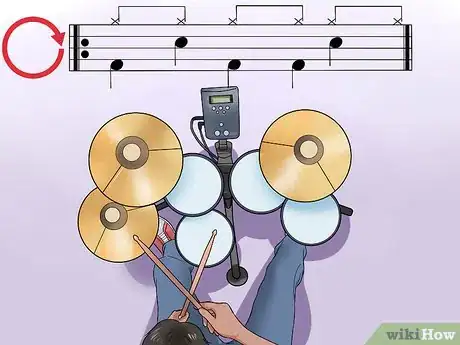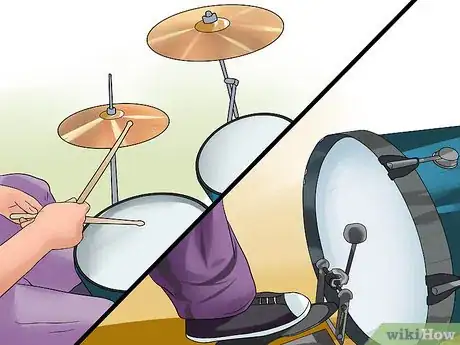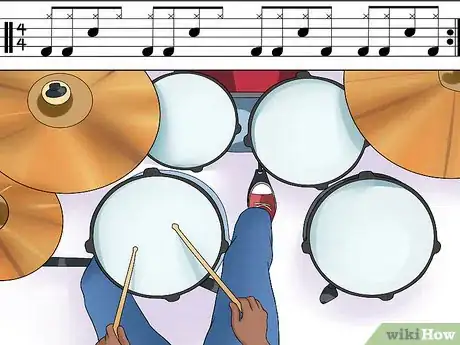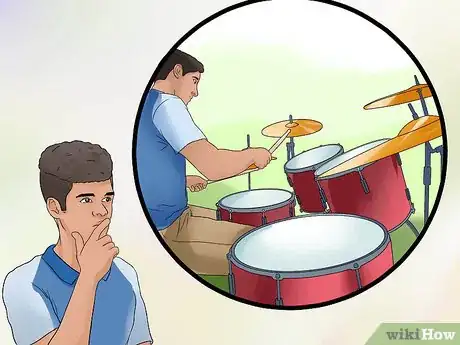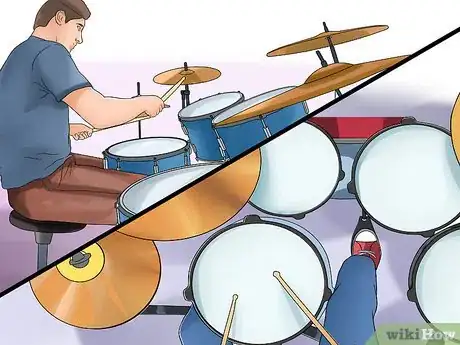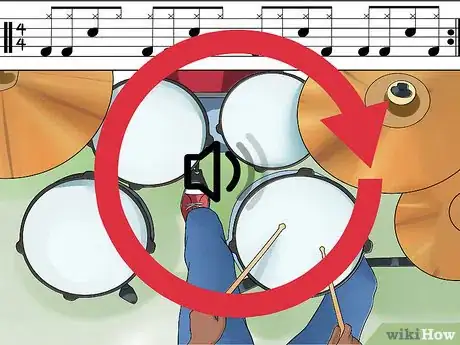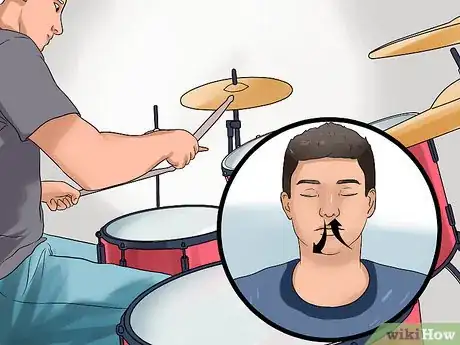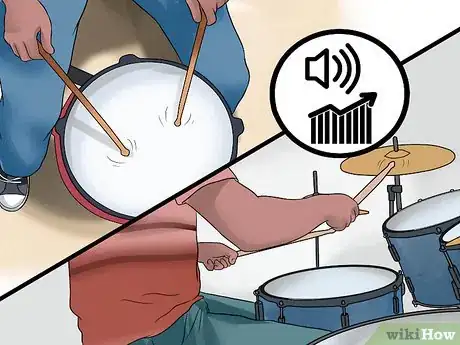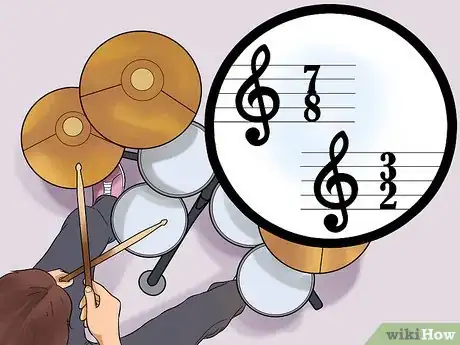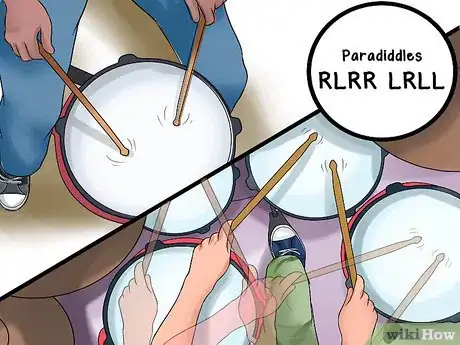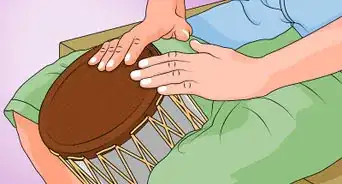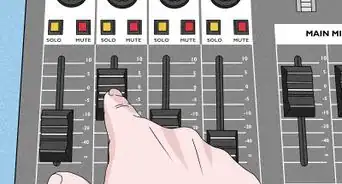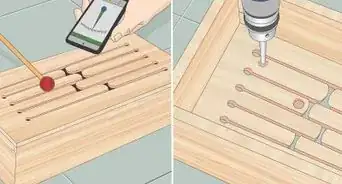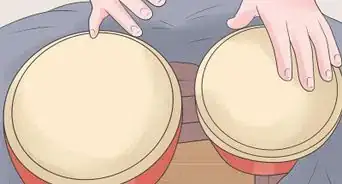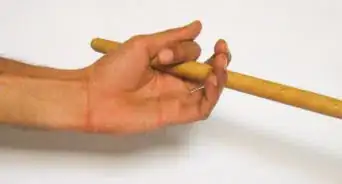This article was co-authored by Matt Khoury. Matt Khoury is a seasoned drummer with over 25 years of experience. He started playing in high-school band and at church, which expanded into opportunities to play with bands in front of thousands of people across the United States.
There are 9 references cited in this article, which can be found at the bottom of the page.
This article has been viewed 111,016 times.
Drummers get the least solo time of any instrument, but that's only because they are so essential for the rest of the instruments to keep time. When everyone else finally break away and you're alone on the throne, it can be intimidating to take control of the song for yourself. But some confidence, practice, and a basic idea of structure are all you need to start soloing whether you're a beginner or a seasoned pro.
Steps
Composing a Good Solo
-
1Treat a solo like a story, complete with characters, tension, and plot. A good solo doesn't have to be blazing fast, technically showy, or immaculately planned -- it has to entertain the audience. Jazz instrumentalists have known for decades that a good solo, improvised or otherwise, is like a short story. It must grab the audience with a simple, recognizable groove, grow in suspense or intrigue, then explode with a triumphant climax. While this may seem silly, taking a holistic, story-telling mentality will do wonders for your work:
- Think of each drum as a character. Which one is the protagonist, holding everything together? Most often than this is a snare, kick drum, or high-hat keeping time.
- Like a good thriller or dramatic scene, how can you use silence to increase the tension? What about a burst of volume and power roaring in like a sudden plot twist?
- Movies and stories get repetitive if they show the same scenes or conflicts over and over again -- how can you get off of your favorite drums and introduce a new "character?"[1]
-
2Start slowly and rhythmically, often repeating the basic groove of the song. Starting with your most impressive or fast stuff leaves you nowhere to go but down, so save the technical flash for the end. For starters, you want to help the audience get into the groove of the solo. Don't forget that, up until this point, you provided the entire rhythmic backbone of the song. Beginning with 1-2 bars of the basic groove establishes the rhythm for the audience and the fact that you're about to go it alone. It also is a simple starting ground, allowing everything after it to get more and more impressive.
- Have the rest of the band drop out or stick to very basic rhythm duties. Drums solos get complex and don't mesh well if the rest of the band is trying to be impressive as well.[2]
Advertisement -
3Keep time with either the hi-hats, bass drum(s), both, or none. Not all drum solos need to keep time throughout, and many will flicker in and out of keeping time. But for beginners keeping one hand or foot as a metronome is a great way to stay grounded while you explore the kit. It may be a good idea to use different foot patterns, tempos, and time signatures throughout your solo, but this can only happen once you've established the song's "normal" rhythm.[[Image:Play a Good Drum Solo Step 3.jpg|center]
-
4Figure out 2-3 "safe spots" that you can always come back to if you get lost. Even advanced drummers can get caught up in a solo, taking them into strange patterns, tricks, and new ideas. But you still need to keep the basic groove of the song alive. A good way to do this is to memorize a few basic grooves that you can use to "ground the solo." You play 1 bar of the groove, then 2 bars of out-there improv. You can then come back to the groove for a bar, re-establishing the rhythm, before diving back off the deep end.
- When practicing, master a few "mini-solos" or sections that you enjoy playing. If you're ever not sure what to play next in a solo you can fall back on these building blocks.
-
5Remember that more notes don't always equal a better solo. Good solos are not all about speed, and too much speed may actively ruin a solo. Think of a roller coaster -- if they all started with the high-speed drop and never did anything else, then every ride would be the same and they'd get boring quickly. You want to build the suspense by varying speed, timing, and fun tricks so that each one feels more exciting than the last, which will guarantee the best response once you finally do show off your top speed.
- Remember -- the goal is to entertain, not to show off your skills.
-
6Consider common "compositional ideas" to start practicing with structure. A good place to start soloing is by mimicking other solos, finding common patterns and ideas shared by many drummers. You can, and should, try to imitate the solos you admire. Keep an ear out for the following forms, which can give your solos instant shape and structure:
- Call and Response: Made famous by the blues, this is when you imagine two "voices" in the drums -- one that "asks" a question, the other that answers it. One voice might be your toms and the other a snare, or you can let the other instruments be the call while the drums respond.
- Theme and Variation: You play one common lick or riff over and over again. However, with each bar you subtly change things, so that by the middle of the solo you're playing a completely different lick than when you started. You can then bring it full circle back to the original theme.[3]
-
7End the solo by coming back in time, either softly or with a climactic bang. If the song is going to continue after your solo, many drummers will use the last 3-4 bars to quiet down, signaling closure and helping the band hop back in time. Other songs need to end with your best stuff-- a triumphant finale that brings everything to a close.
- Talk to your bandmates ahead of time and organize a "cue" for them to come back in. It could be a simple silence or a recognizable cymbal pattern -- anything to cue them that they need to play again.[4]
Improving Your Solos
-
1Stay relaxed and loose, even during intense solos. One of the keys to smooth, fluid solos is remembering to remain relaxed. Even as you're flying around the kit, remember to keep breathing. It sounds like a silly thing to remember, but many young drummers instinctively hold their breath when things get difficult, which freezes them up and slows down their muscles.[5]
- Don't tense up your muscles to force yourself to move faster. Keep your joints loose and relaxed.
-
2Use dynamics, or changing volumes, to create tension. Remember, your audience will be entertained if you take them on a journey. Creating soft, quiet moments will make the intense moments much more powerful, as they will be noticeably more forceful compared to the softer playing right before it.
- Remember that you can use dynamics on every single piece of the kit, from floor toms to crash cymbals.
- How smoothly can you ratchet up tension? Try playing a roll on a snare or cymbal, starting from almost silent and transitioning smoothly into the loudest you can play.[6]
-
3Drop into different time signatures, or no time signature at all. Playing in an uncommon time signature (e.g. 7/8 or 3/2) sounds impressive in your drum solo, provided you know what you are doing. Feel free to switch time signatures abruptly in your solo to add a new feel, vibe, or spice to what you're playing. Mix it up and be creative -- just make sure you can get back to "normal" by the end.
- This is a common jazz trick by artists from Buddy Rich to Dave Weckl, but even rock drummers use it. Check out Brian Setzer Orchestra's "Rock This Town," for a swing-rock example.[7]
-
4Practice to a metronome, especially if you want to play with "off-time" solos. Even if you leave the strict "1, 2, 3, 4" count, you are still in charge of keeping time for the band. When the solo is over you need to slip back into rhythm or else the band will be in complete rhythmic disarray. The best way to practice this is to play to a metronome. You can leave the beat for a while, but make sure you land right back in time with the machine when you're done.
-
5Continue practicing your rudiments, rolls, and rhythmic consistency to build technical skill.[8] While a great solo is within the reach of most drummers, you won't improve if all you do is beat and bash on the drums each day. To become a better soloist, you need to spend 15-30 minutes every day on the basic, boring technical skills that make up any good drummer's arsenal. Think of it this way -- even the best-planned solo will fall flat if the notes themselves are sloppy, inconsistent, or off time.
-
6Listen to soloists in any genre to pick up tips, tricks, and potential patterns. Even if you're a heavy metal drummer, you can learn tons from famed jazz drummers like Art Blakey, Max Roach, and Buddy Rich. The inverse is true too, as even classic drummers can pick up pointers from the likes of John Bonham and Chad Smith. Each drummer has a unique way of approaching solos, and most famous drummers have trained or played in a variety of bands. Getting as good as these guys is about absorbing new techniques and new influences.[11]
Expert Q&A
Did you know you can get expert answers for this article?
Unlock expert answers by supporting wikiHow
-
QuestionHow can I learn to play drums by myself?
 Matt KhouryMatt Khoury is a seasoned drummer with over 25 years of experience. He started playing in high-school band and at church, which expanded into opportunities to play with bands in front of thousands of people across the United States.
Matt KhouryMatt Khoury is a seasoned drummer with over 25 years of experience. He started playing in high-school band and at church, which expanded into opportunities to play with bands in front of thousands of people across the United States.
Veteran Drummer
-
QuestionWhat if I mess up while I'm doing my solo or my bandmates forget the cue?
 Community AnswerIf you mess up your solo, just keep going, people who aren't musically educated probably won't even notice the mistake. If your band members don't get the cue, don't try to overpower them, follow their lead and speak to them about this later.
Community AnswerIf you mess up your solo, just keep going, people who aren't musically educated probably won't even notice the mistake. If your band members don't get the cue, don't try to overpower them, follow their lead and speak to them about this later. -
QuestionI'm bad at being loose and relaxed. I have control over breathing, but not being loose enough. Any advice?
 Kim GTop AnswererThe best thing you can do is practice your drum solo over and over until you can play it from memory. As you become more familiar with the solo, you will become more loose and relaxed. Don't be afraid to make mistakes as you practice, sometimes these mistakes can lead to an even better solo.
Kim GTop AnswererThe best thing you can do is practice your drum solo over and over until you can play it from memory. As you become more familiar with the solo, you will become more loose and relaxed. Don't be afraid to make mistakes as you practice, sometimes these mistakes can lead to an even better solo.
Warnings
- Take care of your drum kit, making sure to tune it and replace the heads as they get worn -- no one wants one to break mid-solo⧼thumbs_response⧽
- Try not to drag it on for too long. Drum solos are the quickest to get boring, as people are more used to following melody instruments.⧼thumbs_response⧽
- Don't try to show off what you don't know, try to entertain the audience⧼thumbs_response⧽
References
- ↑ http://www.drumtips.com/how-to-play-a-drum-solo.htm
- ↑ http://www.freedrumlessons.com/drum-lessons/drum-solos.php
- ↑ http://www.drummerworld.com/forums/showthread.php?t=80154
- ↑ www.rockdrummingsystem.com/underground/drum-lessons/building-a-drum-solo.php
- ↑ http://www.freedrumlessons.com/drum-lessons/drum-solo-dave-2.php
- ↑ www.rockdrummingsystem.com/underground/drum-lessons/building-a-drum-solo.php
- ↑ http://www.freedrumlessons.com/drum-lessons/drum-solos.php
- ↑ Matt Khoury. Veteran Drummer. Expert Interview. 21 March 2019.
- ↑ http://www.drummingweb.com/linear.htm

